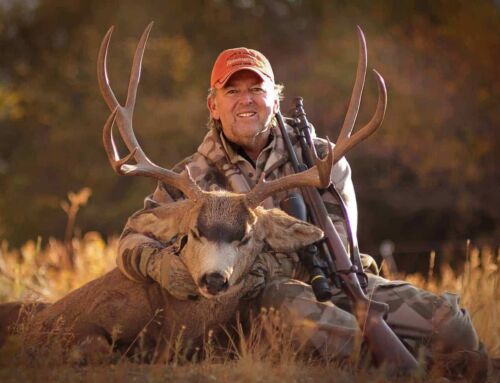 Jason Morton spotted the buck and knew right away the animal was old. The deer was a bag of bones, and walked stiffly with a slow, hip-swaying gait. The 7-point antlers were on the heavy side, but stubby and going downhill from what the rack must have been a few years ago.
Jason Morton spotted the buck and knew right away the animal was old. The deer was a bag of bones, and walked stiffly with a slow, hip-swaying gait. The 7-point antlers were on the heavy side, but stubby and going downhill from what the rack must have been a few years ago.
The “Legend,” as the buck was known around this part of southeast Kansas, walked closer, and Jason had a decision to make. He raised his CZ rifle in 6.5 PRC and looked once more at the ancient deer through the scope. Doubt he’ll make it through another tough winter, Jason thought as he pressed the trigger.
Minutes later guide Brian Helman got a text but no picture: Ever noticed anything strange about the Legend? Brian had gotten hundreds, maybe thousands of camera images of the buck over the years, and from those pictures he knew the animal was at least 8 years old and maybe older. That a whitetail could survive that long in the wilds of southeast Kansas was amazing, but other than that Brian hadn’t noticed anything weird about the deer.
He gunned his truck down the gravel road to see the deer.
“That’s the Legend all right,” Brian said as he examined the bony, scuffed up buck. He picked up the rack and did a double take. “But I’ve never seen that before!” Smack in the middle of the 2 antler bases was a third hard antler, bigger than a silver dollar and flat and concave.
One of America’s top whitetail scientists has seen, studied and handled tens of thousands of skulls and racks over the years and has never seen one like Jason’s buck. “It’s too unique to have been studied,” says Dr. Grant Woods. “I’m not familiar with any other concave base between normal antlers. This is so rare I suspect it was caused by an injury and not genetics.”
Kip Adams, Chief Conservation Officer for the National Deer Association, agrees. “The cells around an antler pedicle are responsible for antler growth,” he says. “If you move those cells to another part of a deer’s head and body, you can grow another antler, or antler like projection, from that new spot.”
Kip suspects that within the last year or so, this buck injured one of his pedicles and some of the material seeped over to that spot between the antler bases. “I think a year or so ago when antler growth began the deer grew 2 normal antlers plus a third antler-like projection from the area between them.”
Both biologists believe the buck’s advanced age had nothing to do with the unique rack growth. It’s very possible the deer didn’t have the third antler in years past since Brian had so many images of the buck and so much history with him, although admittedly the flat and concave growth was tough to see from a distance.
“I’m guessing it’s something that happened recently,” says Kip Adams. “For sure it’s a very rare and cool rack, a real trophy.”
POSTSCRIPT: Jason Morton, VP Marketing for CZ-USA and Colt, shot the Legend one day last December, and in January he sent a jawbone/teeth to the renowned Matson’s Laboratory in Montana for age testing. Results just came back: The buck was 14 years old! The Lab gives the cementum aging reliability of this buck an A, their highest rating.
While captive bucks in enclosures have been documented to be 14 years old, it is extremely rare, unheard of really, for a free-roaming buck to live this long in the wild. For 14 years the Legend had fled coyotes and dodged cars. Guide Brian Helman said that many bow and rifle hunters for many seasons had seen the so-so 8-pointer and passed him up. Amazing!
I believe this to be the oldest wild whitetail buck ever shot on outdoor television. Couple the deer’s age with the rare 3rd pedicle, and it is most certainly one of the most unique! You can see this hunt on an upcoming new episode of BIG DEER TV later this year.







That’s awesome, what a trophy that is to take a buck that is 14 years old. Amazing old beast